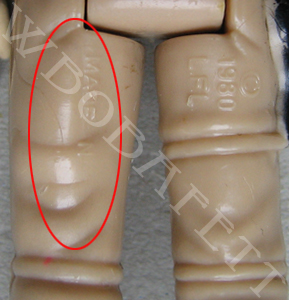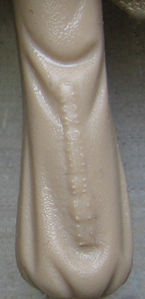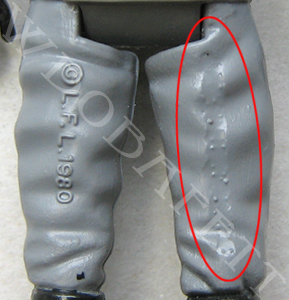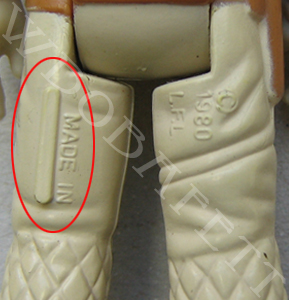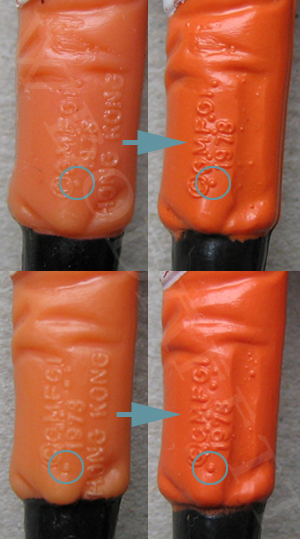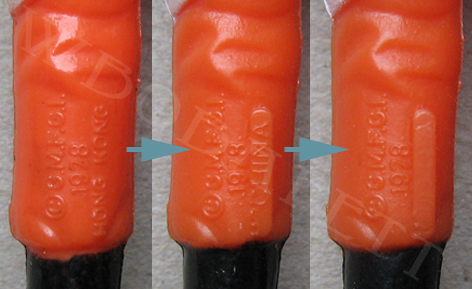COO Terms
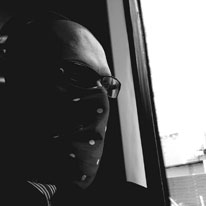
Wolff
TABLE OF CONTENTS
GENERAL TERMS IN COO COLLECTING
All we have left is lots of different forms of the country stamps and many altered stamps. In most cases the country was not changed but simply deleted. The earliest deleted country marks known to me can be found on German (i.e. Han Solo Big Head „pink hands“, General Mills ESB 45back, single stem Blister) and British (i.e. Bossk „fat lips“, Palitoy ESB 45back, single stem blister) ESB cards, but we can be sure in most cases no COO marks appeared not before the ROTJ area.
Especially these deleted country stamps were named over the years and although I think these names are sometimes not so well chosen but they became standard terms in vintage collection. In general the coo is described as it appears on the figures and not how it appears in the „steel-mould“ (the negative). That’s a problem in my own opinion, because the naming sometimes describes the way how it was altered and therefor you should describe like the mould would look, i.e. the so called „melted down“ coo is in reality a „filled up“ coo. The term „melted down“ indicates that the coo on the legs was melted down on every figure which is for sure not the case. Anyway I will give a little inside in the forms, terms and the way these where altered eventually:
Melted down COO
It normally describes that the country is kind of still visible but mostly looks like melted. The term is also used for smooth deleted coos what is a problem to decide which is which. To me the melted down ones always have a little “rampart“ and some letters can be still slightly visible. In this case the coo was scratched out in the mould and was smoothed.
Scarred out COO
It normally means that the figure has a deep scare where the country name formally was. The Scars look like someone had removed the COO with kind of a soldering iron.
In fact the the COO was actually filled up with kind of lead-tin mixture in this area of the mould. These fill-ups are normally roughly made and have air bubbles which appear as dots on the figures.
I’ll have to add some points to the so called „scarred out coo“. This is the only one which is roughly done and with lots of additional material (Tin-lead mixture?) on top of the former COO. That’s the reason why the look of these can change while producing them in high numbers. The fact is that these „fill-ups“ can change or become damaged, fully or partially because of wear on the moulds. A famous example is the half scarred Snaggletooth.
To me it‘s clear that half of the „scar“ broke off while producing full scarred figures. Lots of them where produced and this mistake wasn’t fixed or was changed very late (Perhaps it was simply not noticed in a busy factory). That’s why there are quite a few of them existing. In case of the Lando Bespin scars it is difficult to be sure what happened exactly. There are lots of different scars known, on some scars even single letters can be seen (again?). The fact is the Lando is one of the more common scarred figures and also there was not only one mould to produce him. However, regarding other scarred out figures we can assume that there was 2-4 different scarred out moulds (in most cases 2 different scars are known on Greedo, ATAT Commander, Biker Scout, etc.). But there is a real large number of Lando scars existing. Well, the only way to explain this is that the „fill-ups“ often broke out and in this case often were repaired or the fill-ups were renewed. Its of course just a theory but I think it makes the most sense.
There is another curious scarred out COO which I like to mention. The only known scarred out COO where a country mark was stamped on top of the scar is the famous Macao Biker Scout. Not only is this unique in the world of COO’s but even better, PBP altered it again and removed the „Macao“, you can say „scarred out the scar“.
So as you can see, COO’s can be changed all the time. As I mentioned before the stamps to me mainly are reference marks for the mold-form the figures has. So I bring in a new term: the „COO -family“. (Like a family tree)
In short a coo-family describes all molds that are the same on one character, no matter if they are duplicated exactly or the coo is altered. Ill give an example what can happen to a coo:
No matter how these stamps may have changed. All produced figures are molded the same way. If there are some differences this is caused by the particular material used to produce the figure. Some plastics look sloppy and not very defined after cooling some are more defined are sharper looking but the steel-mold the figure came from is the same. So they all belong to the same mold-family.
Another aspect from the COO-Family is: Same mould but slightly different COO. Regarding the LXW again there can be two slightly different HK COO’s found. These 2 moulds always travelled together and also were altered together.
On this character we have 2 “COO-Families”. Some characters have more, some less. Most families have 2 different coos which travelled together and where altered together. This is really quite a guess, but I assume most „steel-moulds“ were produced as pairs.
If a second pair was needed, new „steel-moulds“ were made. Of course the ones that were already in production couldn’t be duplicated without stopping production. This is the reason in my opinion why every new „steel-mould“ made, has a slight different mould. Some of these changes may be modifications, others like slightly different folds in the cloth-mould were simply not intentional.
There are a lot of production errors on figures, some terms we use to describe them are: “short shots“, “poor shots“ and “cooling errors“. These just describe a factory error which happened during mass production. Sometimes there is not enough plastic injected into the mould, there can be remnants from the former shot still in the mould (especially in the depths of a COO) or the plastic can be pulled out to early and deform while cooling.
So how can we be sure that a COO is no factory error? Well there is a few points that may help:
COMMON SENSE. In my opinion there is no reason to just delete a year and leave the copyright and country on the figure. It also makes no sense to delete a copyright on a licensed figure and leave the country on the figure. A real no COO figure has two forms: no country with copyright and year left or no marks at all! Everything else makes no sense and if such figures appear they are nearly all factory errors in my opinion. (I already mentioned the fact that the „fill-ups“ can break out partially and if such failures are not corrected illogical COO’s can exist in large numbers, see the half scarred Snaggletooth)
QUANTITY. There are some mythical COO’s that have only appeared once. COO collectors all over the world tried to track these down with no luck in achieving one. After years these examples are still the only known and no second example has been found so we can be pretty sure that these are just production errors. On the other hand there are 2 or 3 COO’s which seem to be legit (no factory error possible because of the form) and they are still one of a kind. I will add these in my guide although I normally wouldn’t do because one example that I didn’t even hold in my hands is for real no proof of legitimacy. I of course will mention this in the guide.
You will notice that some COO’s that appeared on the old guide on RS, have been removed. This is because I am pretty sure that they are not legitimate COO variations.
And if it wasn’t already complicated enough by now a new problem hits the market.
Unfortunately when certain areas of collecting become popular, people soon realise that certain “rare“ COO variations can be sold for a lot of money to unsuspecting collectors. Scammer’s with a little exercise and more experience could perfect this method of altering COO’s and fakes could become a problem in the future, so please be careful.
